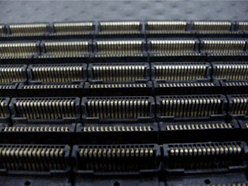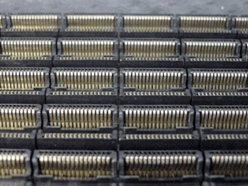![]()
Burn-in-Boards
Burn-in-board BEFORE cleaning with visible oxidise and tarnished leads.

Burn-in-board AFTER cleaning is shining with minimal oxide.

Your Test Boards/Sockets Last How Long?
(Or Technology Wins One!)
by Rudy Sedlak
RD Chemical Company
As presented in ChipScale Review
The problem: Test/burn-in printed circuit boards are very expensive, and as they are used, the semiconductor connection sockets develop increasing contact resistance. The resistance increases to such an extent that after ± 5000 hours of use, the whole board may be discarded. This results in a very high cost per hour of use.
The answer (one is tempted to say the “solution”) to this problem is now available, and it is relatively easy, and inexpensive.
Specifically, when test/burn-in printed circuit boards are new, the connectors should have a resistance of less than 10 ohms, and usually less than 3 ohms. Over time, as a result of picking up oxides from the leads of the semiconductors being tested, this resistance can increase to more than 50 ohms, at which point the connector becomes unusable. When enough connectors go bad, the whole board is discarded.
This issue was initially addressed using a metal stripper, and although early results were promising, other problems were created, and it appeared to not be worth the effort to attempt a clean up of the test sockets.
On further consideration, it was realized that the problem was caused by the oxides on the contacts, not the base metal, and the chemistry of the approach was refined to remove only oxides, without touching any actual metals. This proved to be the answer, but there is a twist to getting this answer.
Test boards loaded with contact sockets were cleaned up, and given to a cooperator, and nothing was heard for months. Then a request came in for more loaded boards to be cleaned. This was done, and submitted, and again months went by. Finally, the cooperator opened up, and told us what was causing the delays.
The cooperator initially did not believe the results of their own testing, and they retested and retested, and retested. The reason why they did not believe the results of their own testing was that the cleaned test boards performed better, with lower resistance, than brand new boards. Specifically cleaned connectors show a consistent 3 ohm resistance or less. Further, the boards were then put into use, and lasted at least as long as new boards, before they needed to be cleaned again.
The resistance life limitation of the test boards/sockets has been extended virtually indefinitely; the test boards will now fail from mechanical issues before they become unusable electronically, thus extending their life many times.
How is this achieved? With an aqueous chemical wash, De-Ox™ (RDZ-1556) six minutes at 120° F, followed by a deionized water rinse and dry.
What are the limitations/downsides? Not all printed circuit board soldermasks can tolerate this cleaner, and the cleaner attacks aluminum metal, so if stiffeners are used on the boards, the stiffener and rivets must be stainless steel, or protected from contact with the De-Ox™ (RDZ-1556).
This new approach will help in lowering costs, and allowing the semiconductor industry to continue to deliver more technology for less money.
De-Ox™/De-Ox™ II
Considerations and LimitationsFor all the benefits that De-Ox™ (RDZ-1556) brings to the test/burn-in industry, it also exposes inherent flaws and quality issues on the connectors & printed circuit boards that are treated. The most obvious is an issue with soldermask. Most US produced printed circuit boards are completely unaffected by De-Ox™ (RDZ-1556), and can handle multiple exposures to De-Ox™ (RDZ-1556) with no effect. However, the soldermask on some printed circuit boards, and apparently more of the boards produced outside the US, is attacked and stripped by De-Ox™ (RDZ-1556).
The issue may be caused by either the choice of soldermask, or the application. The right soldermask will fail if it is not correctly applied, and apparently some soldermasks are stripped, no matter how they are applied. It is known that Taiyo, Huntsman, and Enthone soldermasks, properly applied, are completely unaffected by contact with De-Ox™ (RDZ-1556). It is not known at this time which other soldermasks are prone to being stripped but they do exist. Because of this you should test a corner of the board in De-Ox™ (RDZ-1556) before immersing the entire board. De-Ox™ II (RDZ-1699) was developed for boards that are sensitive to De-Ox™ (RDZ-1556). De-Ox™ II (RDZ-1699) does not attack any soldermask, yet provides the same cleaning as the original De-Ox™ (RDZ-1556).
Another issue that De-Ox™ (RDZ-1556) exposes is quality of (gold) plating. De-Ox™ (RDZ-1556) will not strip any metal (other than Aluminum and Zinc), however, if gold plating is already degraded, either because it was poorly applied, or by wear on the contacts, it can be lifted by De-Ox™ (RDZ-1556). If the Nickel under the gold has become oxidized because the gold is extremely porous, De-Ox™ (RDZ-1556) will remove the Nickel oxides, and in the process loosen the gold plating. It is worth noting that the gold is not actually dissolved, merely lifted from the Nickel surface. If this happens, it rarely occurs on the entire contact, which is what would occur if the De-Ox™ (RDZ-1556) actually stripped Gold, but only on selected areas, which have already been degraded. If this is occurring on relatively new contacts, it is a clear sign that the gold plating is of very poor quality, and the contact supplier should be notified.
If there is actual solder metal, not merely oxides, on the contact, it will not be removed by De-Ox™ (RDZ-1556) (recall De-Ox™ (RDZ-1556) does not attack metals), but this is unimportant, as the oxides are removed, and the conductivity restored. Solder metal has excellent conductivity, it is only the oxides that increase resistance, and De-Ox™ (RDZ-1556) removes all oxides.
De-Ox™ (RDZ-1556) can restore contacts to better-than-new performance by removing all oxides, even those which would be present on unused contacts, and save vast amounts of time and money, but it requires reasonable manufacturing quality in the treated parts to allow its use.
Recommended Process for Cleaning Test Sockets With De-Ox™ (RDZ-1556)
- 1.Immerse or contact via sprays in 100% De-Ox™ (RDZ-1556) for 6 minutes at 50° C (Alternate procedure is 100% De-Ox™ (RDZ-1556) for 3 minutes at 60° C)
- 2.Rinse thoroughly in deionized water. (If using stagnant [non-flowing] rinses, use 3 rinses)
- 3.Dry, using low temperature clean air. (Do not use compressed air, this always has oil droplets, do not bake, this will cause oxide to re-form, and may damage plastic package) Preferred forced drying is to use hair dryer, set on low temperature.
- 4.If test socket has springs, actuate springs many times at each step, cleaning, rinsing, and drying.
Material Compatibility with De-Ox™ (RDZ-1556) & De-Ox™ II (RDZ-1699)
| Material | De-Ox™ (RDZ-1556) | De-Ox™ II (RDZ-1699) |
| Stainless Steel | OK | May Discolor |
| Copper | OK | OK |
| Peek (Carbon Filled) | OK | OK |
| ULTEM | OK | OK |
| EPDM | Do Not Use | OK |
| Polyamide (Nylon) | Do Not Use | OK |
| Polycarbonate | Do Not Use | OK |
| Polyimide | Do Not Use | OK |
| Torlon | Do Not Use | OK |
| Vespal | Do Not Use | OK |
| Aluminum | Do Not Use | Do Not Use |
| Zinc | Do Not Use | Do Not Use |
| Gold over Nickel | OK | OK |